|
Canon PowerShot D10 at Thunderdome
Canon's first waterproof, freeze proof and shockproof digital camera is off to a good start
(by Conrad H. Blickenstorfer and Carol Cotton)
While Canon is the leading digital camera manufacturer worldwide, the company, to the best of my knowledge, never offered a waterproof digital camera, or one that was specifically designed to take the kind of abuse many cameras can reasonably expect in the hands of a boating, camping, hiking and just generally outdoorsy clientele. Competitors had them, most notably Olympus and Pentax, and this year Panasonic and Fuji got into the game as well. Enter Canon's new PowerShot D10, a waterproof, freezeproof and shockproof 12 megapixel camera introduced in February of 2009.
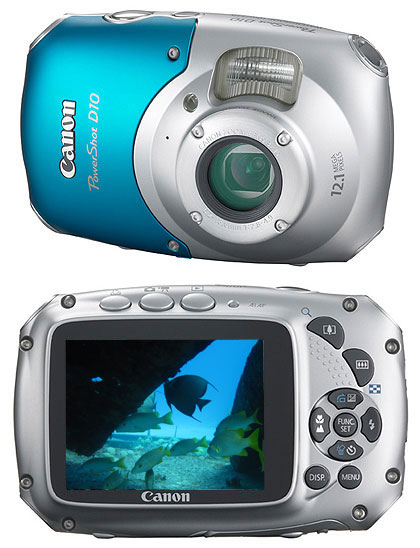
Why a waterproof/freezeproof/shockproof camera?
Canon has been selling protective underwater cases for their cameras for years, so why did they find it necessary to offer a tougher than average camera that's waterproof even without a housing? First, because it was an unexplored market niche for them, and second because it simply makes sense. As the price of digital cameras keeps coming down, more and more people view them as expendable items that they take anywhere. Which means cameras are increasingly becoming exposed to rain, cold, drops and other abuse. So designing one that can handle those conditions is becoming important.
As far as waterproof goes, anyone into boating, kayaking, surfing, fishing, snorkeling or just hanging out by the water knows that taking pictures in the water and underwater is a wonderful experience. And being able to take photographs by the pool or at a beach without having to worry about the camera getting wet is priceless. Protective cases are a good thing, but they are big and bulky and certainly not what you want for a few quick snapshots in the surf. Further, even if you do use a protective case, it's great to know that a potential leak (and they do and will happen) would not kill the camera.
As far as freezeproof and shockproof go, that also comes in handy. Being able to take your camera skiing, snowboarding or hiking in the cold is a good thing. And drops do happen. Digital cameras are small and slippery, and it's all too easy to drop one.
What does Canon offer with the PowerShot D10
This being Canon's first entry into the waterproof/rugged camera space, there are some hits and misses. From a tech spec point of view, the D10 is a 12 megapixel camera with an internal 3X optical zoom, augmented by 4X digital magnification. There is optical image stabilization and you can take VGA movies at a full 30 frames per second. 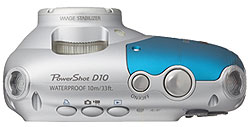 The camera has all the features and goodies common to modern digital compacts, such as advanced face recognition, predefined shooting modes that the camera can select automatically, in-camera editing tricks, and so on. The 2.5-inch LCD is of the wide viewing angle variety, and the camera is equipped with Canon's advanced proprietary DIGIC 4 image processor (DIGIC stands for Digital Imaging Core) that offers excellent speed, good noise reduction in low-light condition, face recognition and more.
The camera has all the features and goodies common to modern digital compacts, such as advanced face recognition, predefined shooting modes that the camera can select automatically, in-camera editing tricks, and so on. The 2.5-inch LCD is of the wide viewing angle variety, and the camera is equipped with Canon's advanced proprietary DIGIC 4 image processor (DIGIC stands for Digital Imaging Core) that offers excellent speed, good noise reduction in low-light condition, face recognition and more.
As far as ruggedness specifications go, the PowerShot D10 is waterproof to 33 feet, has an operating temperature range of 14 to 104 degrees Fahrenheit and is shockproof to four feet. To use technical ruggedness terms, the camera is sealed to NEMA IP68 specifications, and it was also tested according to procedures described in the MIL-STD-810F document, a US military standard for testing. To give you an example of what that means, the drop test specifies the camera had to be dropped onto each corner or other exposed surface three times, which for the D10 meant a total of 30 test drops.
All of this is packaged into a uniquely styled 4.1 x 2.65 x 1.9 inch body that's quite different from most other Canon cameras. The housing is matte silver with a blue insert in the front. Canon offers special straps, different color face plates (the Canon Japan website shows orange, gray and camouflage green) and even Karabiner hooks for that rugged, purposeful look.
Features
With cameras coming down in price so much, everyone is hustling to differentiate themselves with new and improved features. In the last couple of years, there's been a lot of emphasis on ever more sophisticated face recognition. Canon obviously spent a lot of time perfecting face recognition in the DIGIC 4 processor. As a result, the D10 has several face recognition modes. In Face Priority AF mode the camera automatically optimizes all faces (up to 35). In Face Priority AE it concentrates on making sure faces are lit properly under difficult lighting conditions. In Face Priority FE, you can take flash pictures without overexposing a person's face. In Face Priority WB, the camera will make sure faces look natural even if the scene is lit with different light sources. There is also a self-timer face priority where the camera makes sure it finds the face of a person who joins the scene after the initial focus is done. DIGIC 4 also improves the camera's ability to find faces that are not head-on.
The D10's 2.5-inch LCD is relatively small in this day and age of 2.7, 3.0 and even 3.5-inch screens, but Canon made sure it offers a wide viewing angle in any direction and also applied special anti-reflective and scratch-resistant coating. There is also an "LCD booster" where you can increase the brightness with the touch of a button. Very handy.
While many consumer cameras have tiny little buttons, the PowerShot D10 has fairly large ones that are spaced far enough apart so the camera can even be operated with gloves. That comes in handy in the cold and when underwater.
The D10 offers a total of 21 shooting modes. They are auto, program and movie, and then the following 18 special scenes:
- Portrait
- Landscape
- Night Scene
- Foliage
- Snow
- Beach
- Sunset
- Fireworks
- Aquarium
- Underwater
- ISO 3200
- Long Shutter
- Indoor
- Kids & Pets
- Night Snapshot
- Color Accent
- Color Swap
- Stitch Assist
You can select from those scenes, or the camera can pick them automatically.
The D10 has an optical lens-shift anti-blur mechanism to reduce the likelihood of blurred pictures. A "safety zoom" feature combines optical and digital zoom without the sudden image degradation that can happen when you reach the end of optical magnification and go into digital. In macro mode you can go as close as 1.2 inches.
Design and controls
The overall design of the PowerShot D10 is a unique combination of playful (overall look and colors) and tough (some design elements and exposed industrial-looking screws). The body is all round and curvy, which adds to the size of the camera. The zoom is, by necessity, fully internal, but it is not of the folding variety as in other underwater cameras. This necessitates a porthole-like bulge that makes the camera almost two inches thick. Each of the four corners has a large attachment port for strap or an optional multi-purpose karabiner.
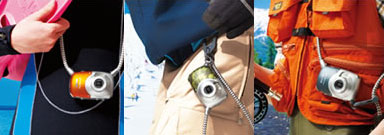
The D10's controls are remarkably simple and mostly follow the current standard for digital cameras. On top are the shutter, the on/off button, one that toggles between video and still shots, one for playback, and one for one-touch printing.
The back features the 2.5-inch LCD sitting centered in a much larger cutout, two separate zoom buttons, and DISP and MENU buttons. There is also a five-way navigation arrangement, with the "FUNC/SET" button in the middle, and four directional buttons each of which also brings up one of the common screen menus.
On the bottom, in addition to the self-locking USB/AV, storage card and power compartment cover, are a centrally located tripod mount and a speaker.
Power
The PowerShot D10 uses a small 850 mAh, 3.7V Li-Ion NB-6L battery. A full charge is good for about 220 pictures or six hours of playback, though that depends on how often you use the LCD. Replacement batteries are inexpensive and widely available, so I'd get a spare.
Canon Powershot D10 at Thunderdome
Back in the early 1990s, there was on French TV an adventure game show called "The Treasure of Pago Pago." It was inspired by a legend of villagers protecting a fountain of pearls under the sea. While Pago Pago is actually a Samoan island and also known as the setting for Somerset Maugham's short story, 'Rain,' much of the taping took place in the Caribbean islands of Turks and Caicos.
In the show three pairs of candidates had to tackle a number of challenges and obstacles before the finalists reached the mythical fountain of pearls located inside an underwater dome of steel. The contestants would freedive into the dome and try to grab as many pearls shooting out of tubes as they could. When they became short on air, they could exchange weight bracelets earned earlier in the contest for air from scuba regulators offered by "mermaids." (see excerpt on YouTube at http://www.youtube.com/watch?v=2Di8XxauVO0).
Though ratings were good, the show ended in 1994 because, depending on the source, of cost reasons or after air embolism accidents when the divers ascended without properly exhaling the compressed air received from scuba regulators. The dome eventually succumbed to the sea and the frequent hurricanes in that part of the world. Fortunately for us, the remnants of the Thunderdome rest at about 35 feet of water, just within reach of the Canon Powershot D10. And so we jumped off the liveaboard "Turks & Caicos Explorer II" off the northwest coast of Providenciales island in full scuba gear in search of Thunderdome. As you can see in the picture below, the once hemispherical dome has partially collapsed.
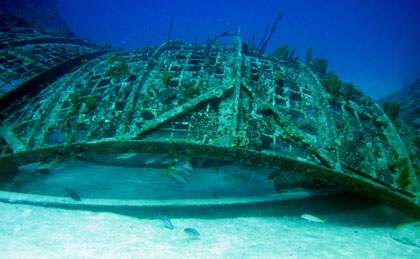
Underwater, the Canon D10 turned out to be a delightful companion for this type of shallow dive. I observed the depth limits and my dive computer recorded a maximum depth of 36 feet, something the D10 easily handled. The picture below shows my dive buddy exploring the remnants of Thunderdome with the Canon D10.
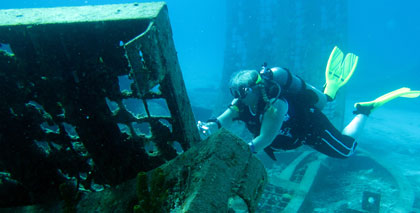
As we swam inside and underneath the wreck of the dome, the small size of the D10 came in handy. Even compact camera underwater housings are fairly bulky whereas the Canon D10 never got in the way at all. There was plenty of life inside the dome.
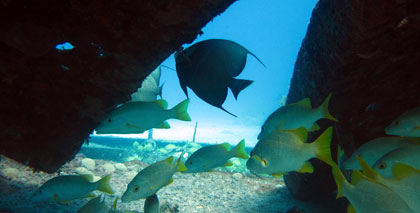
And the below picture shows me taking a shot with the Canon D10 of Carol taking a shot of me with a Canon G10 in an underwater housing.

Taking pictures underwater is very different from taking pictures on dry land. Underwater you don't have time to agonize over settings, study manuals, or spend a lot of time trying to figure things out. Taking pictures must be easy and intuitive, and the Canon D10 certainly came through for us. It was easy to switch between normal and macro (or infinity), it was easy to set the flash, and the Canon quickly locked on with a green rectangle, ready to shoot.
When you're underwater, it's often hard to tell whether a shot is sharp or not (that's where a large LCD comes in handy), but when we later examined the D10 macro pictures, we were stunned how sharp and vibrant they were.
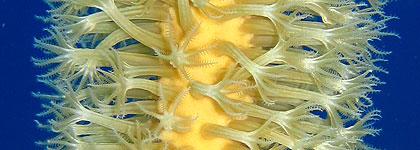
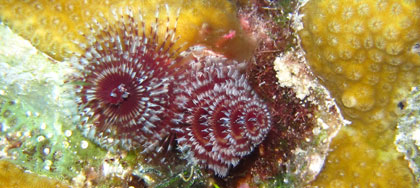
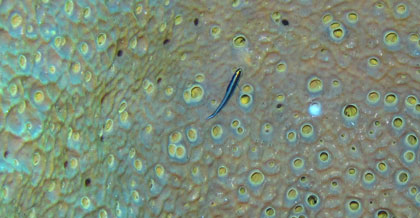
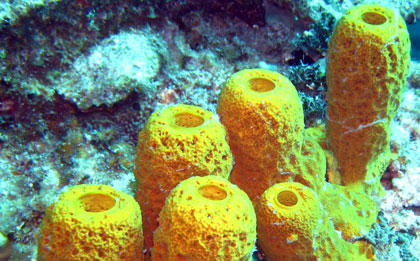
Among the glitches I noticed is that the AF illuminator is way high when you do macro, and the flash gets cut off by the protruding lens dome when shooting close-ups. This means that the AF illuminator isn't as effective in setting precise focus, and that you may get a dark area in the picture where the lens dome gets in the way of the flash. Below you can see this syndrome.
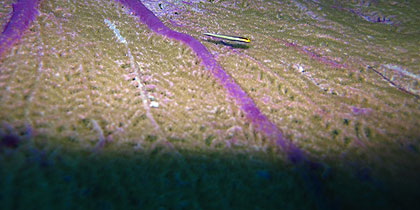
And just to make a great dive even more perfect, I happened upon a nurse shark resting in the shadow of the dome.
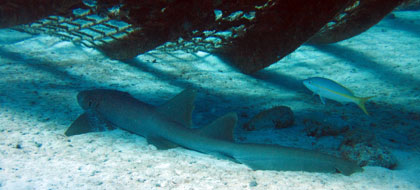
Below is the computer log of the dive with the Canon D10. For the most part of the dive we photographed at 30-35 feet.
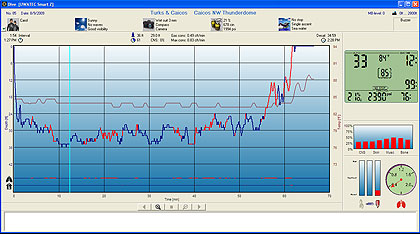
How well did Canon hit the mark?
This being Canon's first entry into the rugged/waterproof digital camera market that's been dominated mostly by Olympus and Pentax, how well did Canon hit the mark?
On the plus side...
- Welcome Canon. It's good to have Canon in this market and it's good to be able to select Canon quality and innovation when it comes to buying a waterproof ruggedized camera. The camera's playful nautical looks make it stand out and probably fit right in with some people's outdoor gear. I also like the large and clearly marked buttons that make handling the camera underwater and in rough conditions easier. Having 12 megapixel to play with while snorkeling, diving or snowboarding is a plus as well.
- A real dive camera. Best, probably, is that Canon's first rugged/waterproof digital offering is actually useful for divers as you can take it down to 33 feet. Most waterproof cameras can only handle five or ten feet, which is good enough for snorkeling but precludes scuba. Some Olympus Stylus cameras can go to 33 feet (and we've successfully tested them as deep as 75 feet), and the new D10 matches that. 33 feet is definitely scuba territory and you can dive reefs and many wrecks within that range. With the PowerShot D10, scuba divers now have a Canon camera they can take on those dives without the need for a bulky underwater housing.
- Tough to the max. We also like the way Canon made the D10 shockproof and even indicated the specific drop test procedures the camera underwent. Multiple drops from a height of four feet is impressive and it's good to know the D10 can survive an occasional drop. We also like the wide operating temperature range, which is likely even wider than Canon specifies as I'm pretty sure it can take pictures past its 104 degree fahrenheit maximum (hey, it gets up to 115 here where I live in central California).
- Quality pictures. Picture quality is what we'd expect from a Canon, i.e. very good. This camera has been criticized by some reviewers as producing soft edges. We did not see that, but then again, we concentrated on underwater photography where the rules are totally different. In that medium, the Canon D10 mostly excelled.
- Bright LCD. The very bright 2.5-inch hi-res display with its anti-reflection and scratch-resistant coatings and wide viewing angle is a good choice for an outdoor and underwater camera, and the one-touch LCD brightness boost will be much appreciated.
- Underwater shooting mode. Canon also gave the D10 an underwater shooting mode as well as a special underwater white balance. This is important as taking pictures underwater is VERY different from shooting on dry land. Water progressively filters out certain colors (first red, then orange, etc.) which is why underwater pictures tend to look all blueish and greenish with little other color. There's also a lot of stuff floating around, making it very difficult for the camera to focus. Good underwater modes and special white balance settings can make for much better pictures underwater.
- Quick and handy. The camera locks onto subjects very quickly. This can be invaluable underwater where things (and the diver) tend to move around a lot. Switching between macro/normal/infinity was quick and easy, and so was switching between flash modes.
Things we weren't so crazy about...
- Size and design. Canon made some interesting choices with its first underwater camera. The camera, for example, is a little chunky compared to its direct competition. It's still compact, but the zoom lens sticks out and makes for a thickness of almost two inches, meaning it won't fit into pockets as easily as some of the competition's smaller underwater models. As far as design goes, people will probably either love or dislike its playful and somewhat cartoonish look.
- Display and zoom. While the 2.5-inch display is bright and useful, it's relatively small for a 2009-vintage camera. At this point we'd expect a 2.8 or 3.0 inch display. Also questionable is Canon's choice of a plain-vanilla 35-105mm equivalent zoom. While underwater it's not critical to zoom in, it is imperative to be able to get close and still have a reasonably wide angle. Starting at 35mm won't do in many situations and I hope Canon will eventually offer a waterproof camera with something along the lines of the 28-112mm zoom Canon is using in other models.
- Video. On the movie side of things, Canon generally equips its compacts with fairly rudimentary capabilities, and the D10 is no different. So while the DIGIC 4 processor can handle H.264 encoding, all you can do is shoot basic 640 x 480 video. That's okay, but it'd be so much nicer to record what's under the surface in at least 720p high definition video.
- Zoom control. One weird thing is that the D10's zoom seems backward. On pretty much all cameras, pushing the right zoom zooms in, the left out. With the D10 it's the other way round, and I constantly pushed the wrong button.
- Feature choice. On the features side, the D10 has all the latest in face recognition, but that will leave divers and most outdoorspeople cold. What they'd much rather have is superior speed and perhaps some extra programming in the DIGIC processor to handle all the many special conditions that confront underwater photographers. Face recognition is good and well, but divers wear masks and the big issues are color compensation, backscatter avoidance, and autofocus that isn't distracted by flotsam and sediment. And, while not essential, a depth gauge/manometer would come in handy.
- Latch. The plastic latch of the battery/memory card compartment's sealed door is a fingernail breaker and looks disconcertingly flimsy. After ocean diving it also accumulated salt that gummed up the spring-loaded action. This needs to be redesigned.
- Cost. The Canon PowerShot D10 lists for US$329. That's okay for a camera that can handle 33 feet of depth, but still a bit costly given the relative lack of features. At US$399, the new Olympus Tough-8000, which also offers 33-foot depth and 12 megapixel, is smaller, lighter, tougher, and has a more useful wide zoom and a larger screen. The new US$399 12-megapixel/10-foot Panasonic TS1 pretty much matches the Olympus except for depth, but can also record 720p video. Canon offers 33-foot depth capability for less, but lags in other areas. Time will tell what the market decides.
Bottom line
The PowerShot D10 is Canon's first entry into the waterproof/rugged camera space where it joins offerings from the likes of Olympus, Pentax, Fuji, Panasonic and a number of specialty manufacturers. The somewhat playfully styled camera is is a bit on the bulky side, but is also well equipped to handle most of the abuse it may encounter outdoors. It can be used in freezing weather (down to 14 degrees Fahrenheit), it is dust and waterproof, and it can handle being dropped from up to four feet.
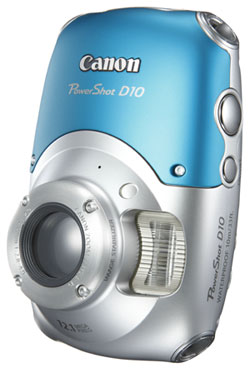 Divers can take it down to 33 feet of depth, enough for many scuba adventures. Our underwater testing was at a 40-foot divesite and we were underwater for an hour. The camera was very easy to operate and locked on quicker than most. Divers can take it down to 33 feet of depth, enough for many scuba adventures. Our underwater testing was at a 40-foot divesite and we were underwater for an hour. The camera was very easy to operate and locked on quicker than most.
The D10 has a relatively small but bright and vibrant 2.5-inch LCD display with anti-reflection and scratch-resistant treatment. The camera's controls are large and arranged so you can operate it with a glove. The basic 35-105mm equivalent 3X optical zoom is not optimal for underwater use where wide angle shooting is almost mandatory, and the zoom buttons are backwards. Optical lens stabilization very effectively reduces blur.
Thanks to Canon's DIGIC 4 processor, the camera offers speedy operation, onboard image correction, and advanced face recognition modes. The list price of US$329 is relatively high, though in line with the rugged/waterproof competition.
We like:
- Waterproof to 33 feet, dustproof, can shoot in freezing weather
- Very easy to handle underwater
- High-res anti-reflective 2.5-inch wide viewing-angle LCD with one-touch brightness boost
- Very effective sensor shift shake reduction
- Large and well marked controls
- Very good picture quality
- All the power of the DIGIC 4 processor
Not so much:
- 3X optical zoom starts at 35mm instead of wide
- Only one underwater mode and one underwater white balance
- Protruding dome makes camera feel bulky
- Dome blocks flash in macro photography
- No high-def video
- Zoom in/out works backwards
- Flimsy battery compartment latch that gums up
|










